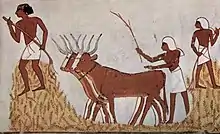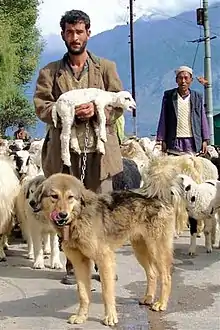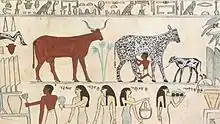驯化
驯化(英语:Domestication)是指一種生物的成長與生殖逐漸受另一種生物利用與掌控的過程,例如人類栽培各種農作物、畜牧,以及切葉蟻馴養真菌。人類驯化动植物的目的主要包括作為食物和衣物的來源、運輸、守衛或是觀賞娛樂用途。常見的馴養動物包括了寵物、家畜等。 人类驯化植物至少在1万2千年前就开始了,例如谷物和葫芦。 农业至少在11个不同的世界中心发展起来,驯化了不同的动物和植物。
动物
最初驯化的年代和地区
| 物种 | 年代 | 地区 |
|---|---|---|
| 狗 (Canis lupus familiaris) | 公元前15000年 [1] | 东亚和非洲 |
| 绵羊 (Ovis orientalis aries) | 公元前9000-11000年[2][3] | 西南亚 |
| 山羊 (Capra aegagrus hircus) | 公元前10000年 [4] | 伊朗 |
| 猪 (Sus scrofa domestica) | 公元前9000年[5] | 近东、中国 |
| 牛 (Bos primigenius taurus) | 公元前8000年[6][7] | 印度、中东和撒哈拉以南非洲 |
| 猫 (Felis catus) | 公元前7500年 [8][9][10][11] | 塞浦路斯和近东 |
| 鸡 (Gallus gallus domesticus) | 公元前6000年[12] | 印度和东南亚 |
| 豚鼠 (Cavia porcellus) | 公元前5000年[13] | 秘鲁 |
| 驴 (Equus africanus asinus) | 公元前5000年[14][15] | 埃及 |
| 家鸭 (Anas platyrhynchos domesticus) | 公元前4000年 | 中国 |
| 水牛 (Bubalus bubalis) | 公元前4000年 | 印度, 中国 |
| 马 (Equus ferus caballus) | 公元前4000年[16] | 欧亚草原 |
| 單峰駱駝 (Camelus dromedarius) | 公元前4000年 | 阿拉伯 |
| 大羊駝 (Lama glama) | 公元前3500年 | 秘鲁 |
| 蚕 (Bombyx mori) | 公元前3000年 | 中国,参见:蠶業。 |
| 驯鹿 (Rangifer tarandus) | 公元前3000年[17] | 俄罗斯 |
| 野鸽 (Columba livia) | 公元前3000年 | 地中海盘地 |
| 鵝 (Anser anser domesticus) | 公元前3000年[18] | 埃及 |
| 双峰骆驼 (Camelus bactrianus) | 公元前2500年 | 中亚 |
| 牦牛 (Bos grunniens) | 公元前2500年 | 中国西藏 |
| 爪哇野牛 (Bos javanicus) | 未知 | 东南亚、爪哇岛 |
| 大额牛 (Bos gaurus frontalis) | 未知 | 东南亚 |
| 羊驼 (Vicugna pacos) | 公元前1500年 | 秘鲁 |
| 雪貂 (Mustela putorius furo) | 公元前1500年- | 欧洲 |
| 番鸭 (Cairina momelanotus) | 未知 | 南美洲 |
| 珍珠鸡 | 未知 | 非洲 |
| 鲤鱼 | 未知 | 东亚 |
| 家养火鸡 | 公元前500年 | 墨西哥 |
| 金鱼 | 未知 | 中国 |
| 穴兔 | 公元前1600年 | 欧洲 |
| 瘤牛 (Bos primigenius indicus) | 公元前8000年 | 印度 |
| 蜜蜂 | 公元前4000年 | 多个地区,参见:蜜蜂養殖。 |
| 亚洲象 | 公元前2000年 | 印度河流域文明 |
| 黇鹿 | 公元前1000年 | 地中海盘地 |
| 蓝孔雀 | 公元前500年 | 印度 |
| 蛮鸽 | 公元前500年 | 北非 |
| 日本鹌鹑 | 1100–1900年 | 日本 |
| 金丝雀 | 1600年 | 欧洲加那利群岛 |
| 鸳鸯 | 未知 | 中国 |
| 疣鼻天鹅 | 1000–1500年 | 欧洲 |
| 雅加犬 (Fuegian dog) | 未知 | 智利大火地島 |
植物
最初的动物驯化影响最大的是控制动物行为的基因,而最初的植物驯化影响的是控制植物形态的基因(种子大小、植物结构、传播机制)以及生理机能(发芽或成熟的时间)。[19][20]

农民、小麦和牛(公元前1422年古埃及)
其他
用來釀酒的酵母菌和食用真菌等等也是人類馴化後的結果。
参考文献
- See Origin of the domestic dog
- Krebs, Robert E. & Carolyn A. . Westport, CT: Greenwood Press. 2003. ISBN 0-313-31342-3.
- Simmons, Paula; Carol Ekarius. . North Adams, MA: Storey Publishing LLC. 2001. ISBN 978-1-58017-262-2.
- Melinda A. Zeder, Goat busters track domestication 页面存档备份,存于 (Physiologic changes and evolution of goats into a domesticated animal), April 2000, (英文).
- Giuffra E, Kijas JM, Amarger V, Carlborg O, Jeon JT, Andersson L. The origin of the domestic pig: independent domestication and subsequent introgression., April 2000, (英文).
- Late Neolithic megalithic structures at Nabta Playa (Sahara), southwestern Egypt. 的存檔,存档日期2008-02-13.
- Source : Laboratoire de Préhistoire et Protohistoire de l'Ouest de la France . [2009-04-17]. (原始内容存档于2009-06-26)., (法文).
- . National Geographic News. 2004-04-08 [2007-03-06]. (原始内容存档于2015-11-27).
- Muir, Hazel. . New Scientist. 2004-04-08 [2007-11-23]. (原始内容存档于2014-10-16).
- Walton, Marsha. . CNN. April 9, 2004 [2007-11-23]. (原始内容存档于2007-12-22).
- 页面存档备份,存于, domestication of the cat on Cyprus, National Geographic.
- West B. and Zhou, B-X., Did chickens go north? New evidence for domestication, World’s Poultry Science Journal, 45, 205-218, 1989, quotationPDF (26.3 KiB), 8 p. (英文).
- . [2010-05-27]. (原始内容存档于2011-10-09).
- Beja-Pereira, Albano et al., African Origins of the Domestic Donkey, Science 304:1781, 18 June 2004, cited in New Scientist 页面存档备份,存于, (英文).
- Roger Blench, The history and spread of donkeys in AfricaPDF (235 KiB) (英文).
- The Domestication of the Horse 的存檔,存档日期2007-02-02.; see also Domestication of the horse
- Domestication of Reindeer 的存檔,存档日期2009-03-16.
- . [2010-05-27]. (原始内容存档于2017-07-27).
- Zeder MA. . Journal of Anthropological Research. 2012, 68 (2): 161–190. doi:10.3998/jar.0521004.0068.201.
- Zeder MA. 2006. Archaeological approaches to documenting animal domestication. In Documenting Domestication: New Genetic and Archaeological Paradigms, ed. M Zeder, DG Bradley, E Emshwiller, BD Smith, pp. 209–27. Berkeley: Univ. Calif. Press
參見
- 育種
- 人工选择
外部連結
- Discussion of animal domestication 页面存档备份,存于
- Guns, Germs and Steel by Jared Diamond (ISBN 0-393-03891-2)
- News story about an early domesticated cat find
- Belyaev experiment 页面存档备份,存于 with the domestic fox
- Use of Domestic Animals in Zoo Education 页面存档备份,存于
- The Initial Domestication of Cucurbita pepo in the Americas 10,000 Years Ago 页面存档备份,存于
- Phytolith evidence for early Holocene Cucurbita domestication in southwest Ecuador
- An Asian origin for a 10,000-year-old domesticated plant in the Americas
This article is issued from Wikipedia. The text is licensed under Creative Commons - Attribution - Sharealike. Additional terms may apply for the media files.


